Understanding Santa Clara University and its Indigenous Legacy
The Beginning
Long before the arrival of the first Europeans, the Bay Area was home to a large Native population for thousands of years divided into over 40 tribal settlements: the Tamien, Chochenyo, Matalan, Sagan, Ohlone, and many others. Today, many descendants call themselves Ohlone, however this term is not used by all Native communities whose ancestral territory is within the greater Bay Area.
Following their 1769 encounter with Spanish explorers, life changed drastically for the Ohlone. The Alta California Missions were established and run by Spanish padres (Franciscan Missionaries) who sought to convert Native communities to Catholicism, assimilate them into European culture, and exploit their labor. Due to labor demands, disease, and unsanitary and crowded conditions, the Indigenous community at Mission Santa Clara faced poor health and high death rates.
Although pockets of resistance existed, the Ohlone’s way of life, identity, and world view were forever changed by colonization and missionization. However, the Ohlone people did not disappear. Numerous family groups have reclaimed their heritage (working to revitalize language, dance, food, and more) and are seeking Federal recognition in our time.
The following historical images were created by Louis Choris (1795–1828) who visited the Bay Area in 1816 as part of a Russian scientific expedition
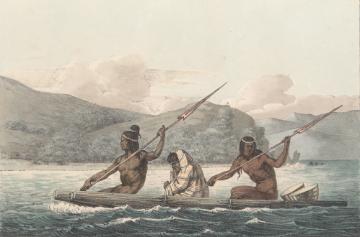
Ohlone Indians in a Tule Boat in the San Francisco Bay
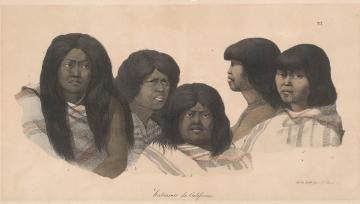
Inhabitants of California, Bay Area
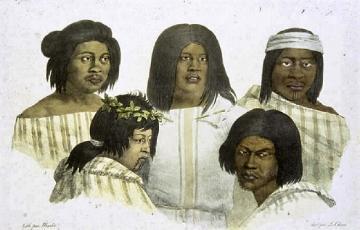
Inhabitants of California, Bay Area
The Roots of Santa Clara University
Santa Clara University sits on the ancestral lands of the Ohlone and Muwkema Ohlone who trace their ancestry to the Mission Dolores, Santa Clara and San Jose. In addition, other indigenous peoples had connection to this area and it was known as Thámien.
Santa Clara University traces its roots to the Mission system in California and the founding by the Franciscans of Mission Santa Clara de Asis on January 17, 1777. The first mission was built near the Guadalupe River (in what is now the San Jose airport) and was damaged by floods. It was then moved further South, and eventually, a third Mission Church was built in what is now the front entrance of Santa Clara University. Due to damage from an earthquake in 1818, the Mission Church was moved to its current location on the campus. Additional details and specifcs about the history and timeline of Mission Santa Clara, can be accessed online.
In 1850, the Franciscans sold Mission Santa Clara and the land to the Jesuits. The Jesuits formally established Santa Clara College (now University) on March 19, 1851.
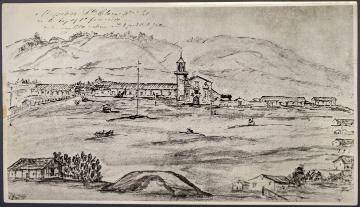
1841 sketch of Ohlone rancheria at Mission Santa Clara
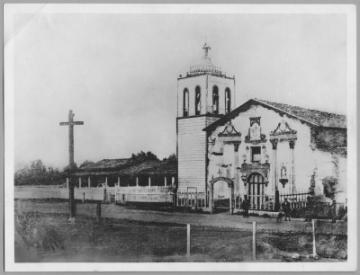
Taken in 1854 by James Ford, is the earliest known photograph of Mission Santa Clara
Understanding the Legacy
While we often talk about the formal founding of the institution, we often do not engage in the discussion about the Mission system and the effect that this had on the local peoples of this area. As a Jesuit institution rooted in our tradition and values, and stewards of this land, we have a responsibility to not only acknowledge but also to reflect, learn and engage with our Indigenous communities. We have created this webpage to serve as a resource for those interested in learning more about SCU is doing and where it wants to go in ensuring this connection.
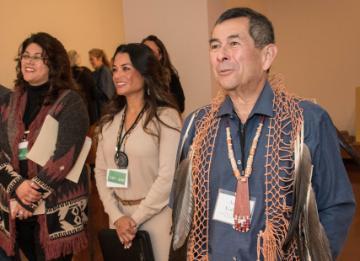
Contemporary Ohlone and Muwekma Ohlone Partners
SCU Land Acknowledgement
“We pause to acknowledge that Santa Clara University sits on the land of the Ohlone people, who trace their ancestry through the Missions Dolores, Santa Clara, and San Jose. We remember their connection to this region and give thanks for the opportunity to live, work, learn, and pray on their traditional homeland. Let us take a moment of silence to pay respect to their Elders and to all Ohlone people, past and present.”
To learn more about the land acknowledgment
Current and Ongoing Initiatives
Saturday, May 4, 2024
To Learn More
To learn more about Santa Clara University's Indigenous efforts and ways to get more involved, please contact the following:
Ohlone Initiatives Implementation Co-Coordinators
Lauren Baines, Interim Director of the deSaisset Museum, lbaines@scu.edu
Ray Plaza, Senior Director, Office for Diversity and Inclusion, rplaza@scu.edu
Community Heritage Lab
Lee Panich, Professor of Anthropology, lpanich@scu.edu
Amy Lueck, Associate Professor, English, alueck@scu.edu
Native American Coalition for Change (NACC)
Claire Alford, President, calford@scu.edu